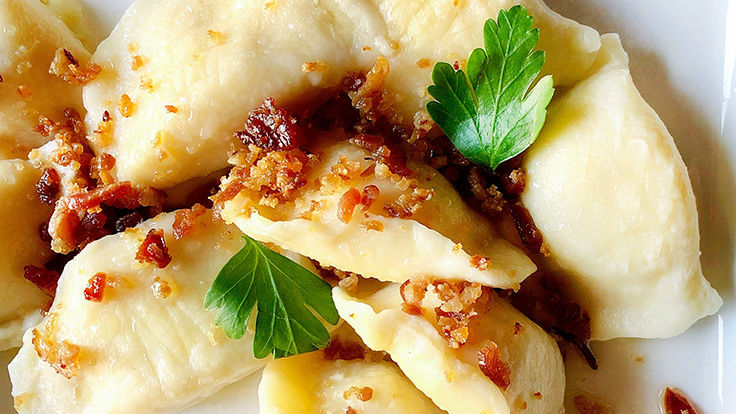For this installment of one dish around the world, we’re looking at dumplings. What qualifies as a dumpling? Dough wrapped around filling or dough with no filling, fried, steamed, boiled, or baked. The dough can be made of any starch—wheat, rice, and potato are all common—and the filling sweet or savory, from Romanian plum dumplings (galuste cu prune) to Brazilian deep-fried, shredded-chicken-filled coxinha. This is not an exhaustive list of dumplings but rounds up a few delicious varieties from around the world and where to find them.

East Asian
Chinese
If there’s a dumpling in your mind’s eye, it’s most certainly this Chinese staple, eaten across the Middle Kingdom. The iconic pleated, crescent-shaped dumplings are jiaozi. When boiled they’re called shuijiao (shui means water), when steamed zhengjiao and, when pan-fried with that beautiful lacy crust, guotie (sometimes called “pot stickers”). The most standard jiaozi is minced pork with chives, but beef, chicken, shrimp, and mutton are all common, usually with chopped vegetables like leek, mushroom, carrot, scallion, and Napa cabbage. A delicious and popular vegetarian option is egg with chive and leek.
Broadly speaking, northern Chinese dumplings have thicker skins than those in the south, which are thinner and more translucent—think har gow, the steamed shrimp dumpling dim sum staple. Then there are soup dumplings: dumplings eaten in soup are wontons (their wrapper is square where jiaozi wrappers are round); dumplings filled with soup are xiaolongbao, those daintily pleated morsels served in their bamboo steamer and bursting with fragrant broth.
Where to find them: Slurp up a steamer of xiaolongbao at New York MICHELIN Bib Gourmand restaurant Kung Fu Little Steamed Buns.

Japanese
Gyoza are nearly identical in shape to jiaozi but usually have a more pronounced garlicky flavor. They’re most commonly made with minced pork, a bit of cabbage, chives, sesame oil, and/or garlic and ginger. They’re eaten boiled and fried, but the most popular cooking style sees the gyoza first pan-fried so one side has a crispy skin, then steamed quickly in a pan. The result is an addictively crunchy crust that gives way to an aromatic interior. Dip them in a mix of soy sauce and rice vinegar and dab on the chili oil for a spicy kick.
Where to find them: Pair a warming bowl of ramen with a plate of pork or vegetarian gyoza at Chicago MICHELIN Plate restaurant Izakaya Mita.

Korean
Mandu are similar to jiaozi and gyoza in shape and filling. They’re either crescent shaped or round (a half-moon with the ends brought together) and filled with minced pork, beef, or shrimp and vegetables like Napa cabbage and bean sprouts. Kimchi is also a common filling and adds a delightful punch and textural contrast. Mandu’s name changes depending on the filling and how they’re cooked. Use shrimp and they’re called saewu mandu; meat and they’re called gogi mandu. Steam your dumplings and they’re jin mandu; pan-fry them for a delectably crispy crust and they’re gun mandu.
Where to find them: At MICHELIN Plate restaurant Jin Ju in Chicago, go for steamed or fried mandu with either beef or kimchi—plus bean sprouts and tofu—and pair them with chewy, zingy duk boki, rice cakes in a sweet chili sauce.

South Asian
Indian
There are a number of dumplings sweet and savory eaten across India. Gujiya look like empanadas, with a half-moon shape and crimped crust; they're made with semolina or all-purpose flour and filled with khoa (a very low-moisture fresh cheese), dried fruits like raisins, and chopped nuts, and fried in ghee. A popular roadside snack in north India, kachori are puffy balls of dough filled with dal seasoned with spices like fennel, coriander, and garam masala and then fried. We’d be remiss not to name-check samosas, that most widely eaten dumpling, a deep-fried triangle or cone of a wheat dough enfolding potato, peas, and onion seasoned with garam masala, ginger, and sometimes fennel. You can often find them with a chicken, beef, lamb, or cheese filling, too. Scarf them down with a cilantro and mint chutney.
Where to find them: Any Indian restaurant you visit anywhere in the world will serve samosas. At Washington MICHELIN Plate restaurant Indique, the classic potato samosas are accompanied by yogurt and tamarind and cilantro chutneys.

European
Polish
Pierogi are a hearty Polish staple boiled and then sometimes pan-fried. The dough is wheat based (sometimes with an egg, occasionally with sour cream to make it lighter) and the shape always a semi-circle. Fillings can be savory or sweet: mashed potatoes, quark, cabbage, and sauerkraut are very common, as are sweetened quark or seasonal fruits (cherry, plum, apple) for dessert pierogi. In Ukraine, a pierogi is a varenyky, and the savory ones are served with sour cream or butter and topped with fried onions and fried pieces of bacon.
Where to find them: Slice into a heaping plate of sauerkraut and wild mushroom or cheese and potato pierogies at MICHELIN Plate restaurant Krolewski Jadlo in New York, or tuck into spinach or sweet strawberry pierogies at MICHELIN Plate Staropolska in Chicago.

Romanian
Semolina dumplings in a fragrant chicken soup (supa de galusti) is a Romanian classic, the dumplings soft and fluffy and the soup deeply warming. For dessert, slice into plum dumplings (galuste cu prune)—juicy plums encased in a sweet potato dough, boiled and then rolled in breadcrumbs fried with sugar, vanilla, and butter—served with a dollop of sour cream or jam.
Where to find them: You’ll get pretty close to Romanian semolina dumplings at New York institution 2nd Avenue Deli, a MICHELIN Plate restaurant where a steaming bowl of matzoh ball soup awaits.

Italian
Three types of pasta qualify as dumplings: ravioli, tortellini, and gnocchi. Tortellini and ravioli are dough encasing a filling—think cheese, spinach, meat, seafood, and mushrooms. Gnocchi are unfilled, the dough made of egg, potato, semolina, flour, and sometimes ricotta. You’ll notice that round mandu and tortellini look very similar—in a pinch, you can even use dumpling skins to make tortellini.
Where to find them: Fork pear and pecorino ravioli and pumpkin gnocchi at Washington Bib Gourmand restaurant Napoli Pasta Bar and roasted squash and mascarpone tortellini at MICHELIN Plate restaurant Al di Là in New York.

Argentinian
Empanadas are eaten in every corner of Argentina, and the most basic formula you’ll find from tip to top is a wheat dough encasing onions, olives, hard-boiled egg, and ground beef, shaped into a half moon and baked in the oven. Although food in Argentina skews meat heavy, other common empanada fillings include mushrooms, cheese, even a Caprese version (at least 60% of Argentines have some Italian ancestry). Empanadas are beloved and eaten across Latin America: in Chilean empanadas you can find razor clams, shrimp, and mussels; in Bolivia, where one variety of empanadas is called salteñas, a thick outer crust gives way to a stew of beef of chicken with potatoes and peas; vegetarians can go for llauchas, filled with salty, low-moisture cheese.
Where to find them: La Costanera, an oceanfront MICHELIN Plate restaurant in Montara, California, serves empanadas filled with minced meat, chicken, or mushroom. At MICHELIN Bib Gourmand Peruvian restaurant Cabra in Chicago, try goat or aji de gallina (chicken stew) empanadas.

Brazilian
Light is not the word you’d use to describe coxinha, a triangular chicken croquette. It's composed of a wheat flour, chicken broth, and sometimes mashed potato mix filled with shredded chicken, requeijão (like cream cheese in texture), and onions, parsley, and scallions for added flavor. The dumpling is then coated in bread crumbs and deep fried. Cheese-only versions are commonly found at snack bars across Brazil, but take note, vegetarians: the dough may still contain chicken broth.
Where to find them: Crunch into coxinha at MICHELIN Plate restaurant WoodSpoon in LA, or take home a frozen bag of six—add a bag of chewy cheese bread pão de queijo for good measure—from New York MICHELIN Plate restaurant Casa.
Hero image: Kung Fu Little Steamed Buns’ xiaolongbao


















